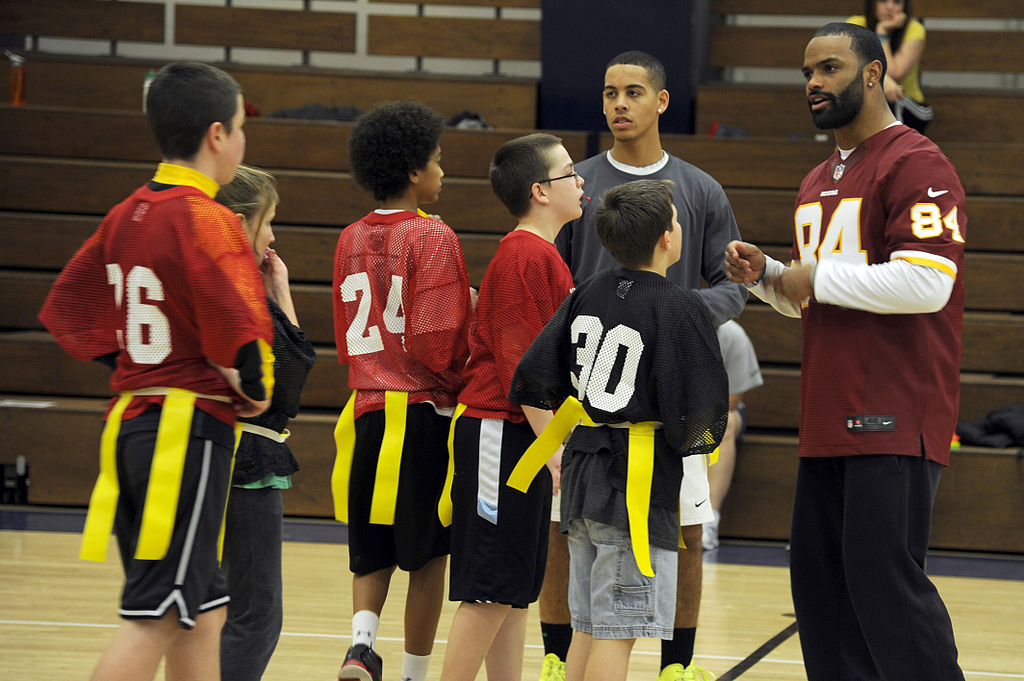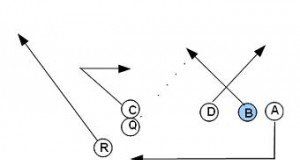
Flag football seems to be quite a different kind of sport that has vast popularity and a fan base around the globe. Like all other games, flag football also consists of some basic rules and terms which make it fair play.
In flag football, there are either 5-5 or 7-7 players in the game and a 12 man campaign. In the game, all the players wear two flag belts around their waists each covering one hip.
To defend or stop an opponent, you simply need to remove one or both the belts from the hips of the opponent.
Heavy tackling and physical contact are not allowed in the game and a penalty is fined for it.
What’s different?
It is quite different and difficult to draw up plays for flag football than normal tackle football.
Being a coach, you know that all the defenders will be focusing on dispatching the flag from your players’ waists, and for that, you need to prepare plays that keep your ball holders away from defenders.
Basic Instructions
We have gathered some sort of guidelines and basic information that will help you in teaching the different flag football runs to your players.
● Pitch runs(right)
There is a running back on the left, right, or behind the quarterback. The runner gets a separation or certain distance from the defenders with the help of pitches.
When a pitch is run right, the quarterback turns to his right hiking the ball. After that, the player running back makes a quick cut towards the right making an angle. Then, the quarterback throws the ball in the direction of the player running back and prepares himself to block the opponents coming by rolling back to the front.
The ball is snapped(at the start) by the center who after the running back receiving the ball, rolls out to the right trying to block any opponent defender from getting the ball.
Note: The left pitch run is just opposite(mirror-like) to the right pitch run.
● Counter run
To teach a counter run to your players in a way that they can convert them into touchdowns, we have collected some key information and used them to create a note written down below.
Counter runs are usually executed by the handoffs but your quarterbacks can also perform this duty. Analyzing that the defender is going to hand the ball off on the play and going right, the quarterback mostly turns to his right hiking the ball and again holding it out.
First, he will make some steps backward, and just before the runner regains the ball, he makes a quick short-cut to his left faking the defender ahead.
With a successful fake, the handoff quickly makes a short right turn to get the ball from the quarterback.
Pro Tip: Counter runs are one of the most effective plays in flag football but it needs great training and some sort of luck. As soon as the defenders see you coming, they will rush to the runner before he reaches the line of scrimmage.
Importance of Running Quarterbacks
A Running quarterback is one of the biggest assets for a team as well as a great threat for the opposition at the same time. Coaches and trainers are continuously preparing game plans and tactics against the quarterbacks as they can come out as a deadly weapon both in Flag football and NFL.
“The more effective the position is, the tougher will be the decision to select a player for it.” Yes, that’s right. Selecting your quarterback can be a big-big headache for you as it requires multiple skills and precise focus.
Only having a good throwing arm and an accurate aim is not all that it takes to be a quarterback. Whether it is a high-school game, college game, or division three-game, only having these two abilities will end up making things worse for you.
How to choose a perfect quarterback for your team?
To make a great team instead of just getting a great player, your selected quarterback must have the ability to run different plays along with the two skills mentioned above. And believe me, your team is not going to succeed in flag football.
While playing a flag football team, you have to select your best players at different positions, and one of the most important positions in them is of the quarterback.
A quarterback can turn out to be a game-changer when it has both the skills of passing and take-off running.
Most of the young quarterbacks have the feeling that their talent is being wasted and thus they decide to stay in the box making passes. This sort of negative thought creates a huge mental error for you.
How can you convince your quarterbacks?
Firstly, it is very important to convince your quarterbacks to understand their strengths and use them for the team’s good.
There is a huge chance that you fail in this process and we should also recommend you not to do many experiments on your quarterback if your team is winning by their small passes and throws.
As observed, most of the defenses struggle in defending against a quarterback that can make passes staying in the box, roll out for a run, or scramble for yards.
Let’s take a situation assuming yourself as a defender. The quarterback is rolling out and it seems that he will pass the ball to the receiver you are marking. Who will you go after?
The receiver or the quarterback? If you go for the quarterback, he can make a pass to the receiver, and if you are going after the receiver, he can pump fake you continuing his run.
Isn’t it a great headache for the defense side?
7 on 7 defense
Whether you believe me or not but this is the defense unit of a team that wins championships. Personally, I feel that the defense is the most crucial part of any team and it takes tough training to create a balanced and high-resistant defense.
We know it’s very exciting to see the high-paced offensive actions and creative touchdowns and so there is a tremendous fanbase for the offenders.
One of the common team strategies is man coverage or man-marking. It is quite effective against an immobile quarterback but as soon as the quarterback starts making runs and scrumbles, the best way to stop them is to go in your defense zone and contain him.
Why is defense important in flag football?
If a running back is going for a touchdown or making good passes, you will surely find it, crucial for everyone going after the ball and the second being ready to pull the flags from the player’s hips if the first couldn’t.
Defense plays a key role in building momentum by being compact and precise. It is always good to have each of the players pulling the opponent runner’s flag. Appointing just one defender for this task may end up losing the game.
Different Defensive Schemes
It is always a wise decision to create some backup formats/schemes to re-deploy your defensive unit if the first primary one is not working.
We have collected two of the most used defensive schemes that teams use to strengthen their defensive unit.
Also Read: Youth Flag Football Pre Season Equipment Checklist
1.Defense(1)
In the format, the cornerbacks(CBs) are placed for man-to-man marking, and the linebacker(LB) and the safety(S) are placed in the modified zone. The Quarterback is being run by the defensive line(LB).
The linebacker and the safety play key roles in making the game momentum in this format so you need to appoint your best players at these positions while playing this scheme. They also need to be quick and good at decision-making because only strength and size don’t matter that much in flag football.
Corners
They perform as guards and ball receivers in man coverage play. If you are stuck with excessive man coverage, call for them. It is a very common position and the players need to be smart enough.
D-line
The quarterback rushes ultimately. The linebacker is lined up to the line on your command and the defenders also pretend to do so but then hold on to defend the quarterback.
It would be good to keep switching your D-line players if you got some better substitutes because they need to run several tiring plays and having fresh legs would be wonderful.
The best time for your D-line players’ substitution is after the first two downs, the quarterback and the O-line players are not familiar with this type of mind-shaking pressure.
2. Defense(2)
You should play your cornerbacks(CB) a short zone coverage in this player format. The safety players will play the deep zone while the linebacker plays a vital role by playing in the modified zone. Two of your linebackers have to rush to the quarterback quickly.
Positions
In flag football, it’s not about the size and strength but everyone has to be quick and wise enough to know whom he has to go after and in what position the team is.
We have described the crucial positions of the game with some detailed information.
Corners
Corners are the players appointed to defend the short zone and to cover the receiver if he is in the zone. If opponents come into the zone, defend them.
Their prioritized duty is to contain the quarterback if he’s going for a run by staying inside the box and maintaining your team flow.
D-line
The main task for the D-line is to rush the quarterback with full force and speed. The LBs can also pretend to do so but they’ll ultimately hold on for the QB if any player is making passes.
Movements
● Quarterback sweep
We will not recommend having running plays in flag football as they won’t be that effective against a well-planned and balanced defense. If you continuously go on with running backs, it will be easier for the opponents to understand your team strategy and plan according to it.
In basic sweep play, the linebacker is just a waste of a player allowing opponents to rush in without worrying for passes. The quarterback runs the sweep staying in his box instead of passing the ball to the RB for it.
The WR plays a vital role in the play as they have to block the crucial downfield. The play can enable some yards for the players and is played mostly by the teams.
● Line release
This can work as a quick choke to the defense as it is unexpected. In this, the center player snaps the ball and forms himself into a pattern.
He receives the floating ball by the quarterback over the heading defense. He needs to be quick, fast, and effective.
Having fast and wise players can turn the whole game around as the linesman seldom catches the ball floating 50 yards. The defense seems to be helpless in this play but at the same time, it also needs a lot of practice.
● Crosses
In spite of being a simple and frequently executed play, Crosses play a vital role in confusing the defense in which players both long-short passes.
Also Read: The Flag Football Drill Guide for Youth (Basics to Know)
In man-coverage, the cornerbacks will be focusing on a particular individual and ultimately collide going for the ball in the air.
Even if the cornerbacks are in the zone defense, you can make them frustrated enough to open the WRs to go open.
You can also make your center run to confuse the opponent’s safety avoiding him from focusing on the ball.
● Boot blast
In this play, you can either run a FB blast or a quarterback bootleg. This play allows you to run multiple routes by lining up different players to choke out the defense.
At the start, you can run your WB keeping it close to the handoff holding ball and following a fake boot. Then after faking him, you can run your boot and go for a touchdown.
Though it is very difficult to execute a running boot blast play, it can create a great impact on the defense and provides you higher chances of scoring a touchdown.








